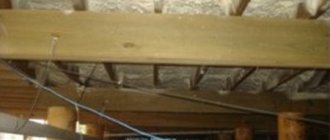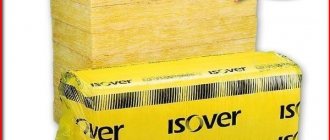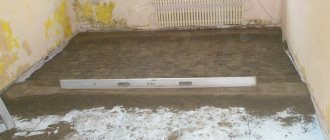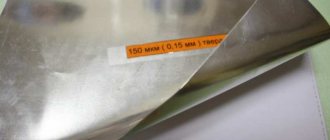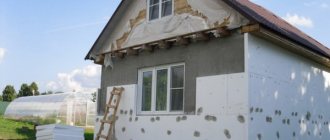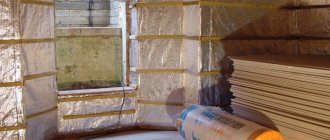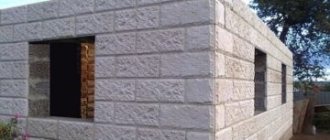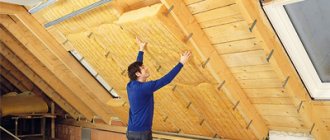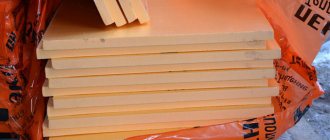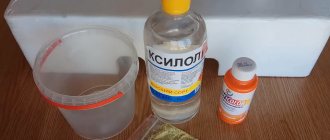The basement is the coldest part of any private home, regardless of what material it is built from. Therefore, thermal insulation of the bottom of the house is a mandatory measure, which is carried out either at the construction stage or immediately after construction. For wooden houses, insulation of the subfloor is a vital necessity. The tree instantly absorbs moisture from the soil and atmosphere. To prevent rotting processes from developing in the wood, it is necessary to equip a high-quality insulation system, which, in addition to thermal protection, includes waterproofing, protection against vapor penetration and ventilation. In the article we publish instructions on how to insulate the underground in a wooden house; you will also learn the various nuances of this work.
Features of insulation
Until a certain point, the most popular material used for insulating walls and other surfaces was polystyrene foam. Although it is still used today, there are products that have been able to surpass it in some characteristics. It is made from polystyrene granules. They go through processing stages during which the base is filled with air bubbles. They provide thermal insulation properties. But the strength of the final product is low. Polystyrene foam breaks and crumbles easily, so when using it as insulation, it is imperative to take care of the protective layer. Several decades ago, a new method for processing polystyrene granules was developed. The result was a new material called extruded polystyrene foam.
Most often, this insulation is not called extruded polystyrene foam. It is better known by the names of the companies that produce it, for example, one of them is Penoplex. Manufacturers Stirex and Technoplex also produce analogues. The insulation itself has the following properties:
- low thermal conductivity of penoplex;
- high density;
- ease of installation of penoplex;
- relatively high strength;
- protection against moisture penetration;
- impossibility of fungus developing on the surface of penoplex;
- light weight;
- absence of harmful secretions;
- additional sound insulation;
In terms of density and strength, extruded polystyrene foam or Penoplex insulation is several times superior to polystyrene foam. During the manufacturing process of penoplex insulation, reactions take place under high pressure, which makes it possible to reduce the size of air bubbles to a diameter of 0.1 mm. This means that per unit area of penoplex insulation there will be more of them than in polystyrene foam, which means the heat-insulating properties will increase. In its normal state, polystyrene foam does not have harmful emissions, which means that floor insulation with penoplex is absolutely safe for the inhabitants. If noisy neighbors live near the house, then penoplex insulation will also provide sound insulation, ensuring sound sleep and vigor in the morning. The material is available in several variations.
Note! Varieties of penoplex insulation are designated by the first letter of the word of the surface for which it is used, for example, “K” - roof, “S” - wall, “F” - foundation. Each type of penoplex insulation differs in density, weight and thickness of the slab
Accordingly, it has different thermal permeability. For example, the one used for roofing has a lower density and, accordingly, less rigidity. There's not a lot of pressure on him there. But its insulating properties remain high, and the price is lower.
Some types of foam do not tolerate simultaneous exposure to moisture and low temperatures. This is due to some looseness of the material, which allows water to seep into the pores. When exposed to frost, it simply bursts, so it requires additional protection. With penoplex insulation, things are more rosy. In the tests carried out, a sample of penoplex insulation was immersed in water for 30 days. At the same time, only 6 grams of additional weight were added to the weight of 100 grams. And this was due to the raw edges along which the trimming took place.
Due to the fact that under pressure, bubbles of the correct spherical shape are formed in the penoplex insulation, the resistance to compressive forces increases. But there is also a nuance that should be taken into account when handling penoplex insulation. For example, penoplex insulation does not withstand the effects of various solvents. The insulation can simply dissolve in acetone. Therefore, if painting is planned along with the installation of penoplex, then it is better to first cover the insulation with film or completely complete the installation of penoplex insulation, postponing work with paints.
What should you pay attention to?
The density of the purchased polystyrene foam should be 35 kg per m3 or higher. Materials for work should be purchased only from sellers with a good reputation. Expanded polystyrene boards are often sold with defects, so it is important to visually check their quality before purchasing.
- Saving on the thickness of the insulation can negate the results of the work done.
- For installation of anchors, only high-quality drills should be used.
- With significant ceiling heights, it is safer to use strong sawhorses or low scaffolding than stepladders or chairs.
- It is recommended to hold the hammer drill with both hands, as it may jam during operation.
Types of cellar ceilings
When the pit has been dug and all the preparatory work has been done, it is necessary to decide on the type of cellar roof, as well as what materials to use for its arrangement. Let's look at the types of ceilings for the cellar.
Support beams
If you decide to make a cellar roof from load-bearing beams, we recommend using railroad rails. You can purchase the product by ordering them in special workshops or at scrap metal collection points. To install the beams, it is necessary to leave special beds, which perform the additional function of firmly fixing the entire structure (the photo shows a roof made of steel beams)
Installation of the floor with load-bearing beams is carried out in the following way:
- iron reinforcement rods are fixed between the beams and tied with knitting wire;
- when the reinforcing mesh is ready, make wooden formwork and lay a layer of waterproofing on it;
- a frame is installed directly under the formwork to hold the concrete mass;
- the structure is poured with concrete, the pouring process must be continuous and uniform;
- the finished ceiling of the cellar is additionally insulated with any building material, for example, you can use ordinary roofing felt.
Wooden roof
The ceiling in the cellar is made using wooden beams. The photo shows an example of a wooden roof
Installation of wooden beams is carried out as follows:
- install beams on the basement walls;
- to obtain additional support, small bars are mounted to the side of the beams;
- the roll is laid using self-tapping screws;
- a vapor barrier is performed, and thermal insulation is laid on top;
- install plywood sheets and treat them with antiseptics and mastic;
- lay roofing material.
Prefabricated monolithic slab
When choosing a prefabricated monolithic floor in the basement, you should consider the use of a construction crane. Before installing the roof, you should make sure that the width of the slabs corresponds to the width of the cellar.
These plates are considered the best and most durable material. The photo shows a roof made of a prefabricated monolithic slab
You can learn more about how to make a monolithic ceiling from the video
Monolithic slabs
Monolithic slab flooring is made using concrete and reinforcement cage. The photo shows a cellar roof made of a monolithic slab
To install a monolithic floor, you must perform the following steps:
- the slab should be located on the walls of the room, the walls serve as support;
- to maintain the integrity of the structure, beams are fixed under the formwork;
- so that the solution does not leak out during pouring, it is necessary to seal the boards and formwork;
- knitting the frame with reinforcing mesh is performed after the final installation of the formwork;
- when the mesh is ready, concreting is performed;
- To avoid the formation of internal cavities, the solution is subjected to a vibration process, this is done using ordinary timber or special equipment.
When a structure is poured with concrete, it must be allowed to dry well and harden; as a rule, this process lasts about a month. It is worth noting that experts recommend double reinforcement to obtain greater reliability of the entire structure.
Waterproofing paints
Such paints are mixtures of bitumen and polymer components that impart water-repellent properties. Such compositions should be applied with a brush and in several layers. Thus, the wood will receive a high-quality moisture-proof layer. Also, similar paints can be applied to the screed.
You can start painting with a waterproofing compound only after the following procedures:
- Sanding wooden floors.
- Cleaning floors from dust and dirt.
- Drying wooden parts.
- Careful treatment of hard-to-reach areas (joints between joist frames and walls) with waterproofing varnishes.
- Painting the rough base.
What material is the floor insulated with?
The construction and installation of floor slabs is carried out in various ways, which, like the materials offered, are sufficient. It all depends on the features of the structure, individual requirements, owner preferences and financial capabilities. Many insulating raw materials have high-quality properties, good characteristics, and during operation receive only high marks.
Expanded polystyrene
Industrial enterprises produce several types of special slabs that can be used for insulation.
When choosing a material, you must pay attention to the purpose of the room and the further load on the floor.
At the initial stage of the process, a thick layer of gravel is laid on the base of the prepared surface, which is covered with a concrete screed. Next, the floor is waterproofed. At the last stage, a wide, soft and comfortable roll of material is stretched.
Extruded polystyrene foam
These boards contain more durable materials. Construction raw materials have a high density and are used when it is necessary to support large weights and loads.
Expanded polystyrene practically does not absorb moisture; it is used in places even with high groundwater levels. The easy-to-use material is attractive due to its low price and does not require the help of special equipment during the work.
Polyurethane foam boards
Of the large number of tiled insulation materials offered, the best option is only rigid materials with a uniform structure and closed cells. They perform floor insulation with such building material more efficiently, in a short time and without extra costs.
Some types of insulation are covered with foil
Some types of polyurethane foam boards are covered with aluminum foil or fiberglass. Such additions increase thermal insulation properties, reduce moisture permeability and distinguish foam plastic from other similar materials.
Mineral wool
Rigid cotton wool boards are chosen as thermal insulation in a wooden house. The material is characterized by high resistance to deformation. You can install such an insulation system yourself, since the entire installation process will not take much time. The fibrous material absorbs moisture well; it is laid out over an unheated basement between two waterproofing layers. To insulate floors in residential premises, it is recommended to use ten-centimeter thick mineral wool.
Expanded clay
Bulk air material can replace three layers at once in insulating a home floor: concrete base, gravel, thermal insulation. Fill the drainage in layers, periodically compacting each layer. At the end, the expanded clay is poured with a solution of cement and sand. When the three-centimeter crust has hardened, waterproofing insulation and concrete screed are laid under the finished floor. After the insulation work has been completed, they begin laying the laminate.
Foam glass
Proper insulation with this material is carried out as follows:
- lay out a ten-centimeter gravel layer;
- pour concrete screed;
- a special adhesive composition is applied to the ends of the insulating blocks;
- After the glue has dried, the heated floor structure is installed.
In rooms with high humidity, to enhance waterproofing, roofing felt, two layers of polyethylene film, and a cement screed are laid over foam glass. Such actions are usually carried out if the final flooring is made of ceramic tiles.
Granulated slag
The material has high thermal insulation properties, but the by-product of iron smelting contains harmful impurities. In the construction and insulation of country houses, they use material that has undergone careful processing and has a document confirming compliance with regulatory requirements.
The slag is laid directly on leveled ground, without the use of waterproofing. The thickness of the layer should be 40 cm. Next, lay a layer of insulation. The poured concrete screed completes the process. The flooring can be laid out from any material you like.
Ecological wool
Fluff pulp is convenient in the work process. The environmentally friendly material is not damaged by rodents, insects, or fungi. When wet, it does not lose its protective properties, does not shrink, and when ignited, does not support the fire, but smolders. The material is used in dry form and with a solution.
This wool is easy to install
What is the best way to insulate a subfloor?
Insulation is selected depending on the behavior of the basement at different times of the year.
The choice of material is also influenced by the following factors:
- Indoor humidity level;
- Availability of heating;
- Availability of drainage around the building;
- Purpose of the underground.
Construction stores offer thermal and waterproofing materials with various characteristics. The following are popular and available:
- Styrofoam. The cheapest insulation. It is distinguished by its lightness, resistance to rotting, moisture resistance, and low price. The combination of these qualities makes foam plastic the most popular material for insulating wooden houses. The disadvantage of polystyrene foam is that it attracts rodents, is fragile, is highly flammable and releases harmful chemical compounds into the atmosphere.
- Expanded polystyrene. A substitute for polystyrene foam, which is more durable and has a tongue-and-groove system for a seamless connection. The material is often used to insulate basements from the outside and inside.
- Polyurethane foam. A sprayed material that fills all cracks when applied to surfaces. Creates a completely sealed coating, does not burn, does not rot. Disadvantages of the material: high price and the impossibility of self-application without special equipment.
- Penofol. Flexible insulation. Provides decent thermal insulation. Fireproof and waterproof.
- Minvata. Soft insulation, suitable for use only inside absolutely dry rooms. Under the influence of moisture, mineral wool begins to rot and gradually decomposes.
- Expanded clay. The use of this bulk material is only possible for insulating the floor and protecting the foundation from the outside.
Features of the material
Penoplex is an extruded polystyrene foam - insulation produced using a special technology, thanks to which the output is a material with improved strength properties. You can read about the characteristics and advantages of EPS in the article “Step-by-step instructions for thermal insulation of a log house with polystyrene foam.”
Insulation characteristics
- Water absorption. The material shows minimum values for the volume of absorbed liquid. In this case, water, if it penetrates, then only into the upper layers, inside the structure consisting of closed cells, the access of liquid is completely closed;
- thermal conductivity. The performance of penoplex is very low - 0.03 W/m-K, and the values remain unchanged, regardless of operating conditions. Therefore, the material can be used for thermal insulation of the roof, foundation, basement, as well as floors and basements;
- environmental friendliness. The insulation meets environmental standards, which is confirmed by relevant certificates;
- vapor permeability. This indicator also has low values. The material does not allow steam to pass through itself, which on the one hand can be called a positive property, since condensation does not accumulate in the insulation, which, at critical values, transfers to wooden walls and causes rotting. But on the other hand, the material does not allow the wood to breathe, which contributes to the creation of a greenhouse effect in the room;
- strength. As a result of using the extrusion method, a homogeneous material consisting of tiny cells is obtained. This structure provides high compressive strength;
- chemical resistance. The insulation interacts well with a large number of substances used in construction: alcohol- and water-based paints, acids, alkalis, oils, concrete mixtures, etc.;
- life time. The material retains its properties for 50 years;
- fire safety. Penoplex has a flammability class of G4, which indicates a fairly high degree of flammability. Therefore, when using the material, it is necessary to use fire retardants;
- operating temperatures: from -50 to + 75 degrees.
When heated, the insulation releases harmful substances, so it is not recommended to use it for thermal insulation of the walls and floors of baths and saunas, where the temperature can reach up to +95 degrees. It is especially dangerous to use it to insulate the ceiling of a steam room, since according to the laws of physics, heated air is always directed upward.
Types of Penoplex
- Thermal insulation boards for insulation of external and internal vertical structures: walls and partitions. The insulation has a milled surface, which improves adhesion to adhesive and plaster solutions. Density 22 kg/m3.
- Universal insulation of the “Comfort” series. Suitable for finishing floors, including on the ground, plinth, foundation, roof, walls. The material can withstand high humidity well, so it can be used for thermal insulation of bathrooms, bathhouses and saunas. Density from 22 kg/m3.
- Thermal insulator for pitched roofs. The material has a U-shaped edge on all sides, thanks to which the plates fit comfortably and easily. As a result, a flat surface is created, due to which the thickness of the thermal insulation is significantly reduced. Density 26-34 kg/m3;
- Foundation cladding slabs. The material is characterized by increased strength and wear resistance and can withstand increased loads. Used to insulate foundations, floors, and basements. Excellent for finishing garden paths. Density 27-35 kg/m3.
Ventilation device
The first stage of insulation is the installation of a ventilation system in the underground, which will ensure air circulation inside the room and prevent the formation of condensation on surfaces.
Underfloor ventilation consists of installing two pipes on different sides of the room. The optimal location of pipes is on the south and north sides of the house. The installation of pipes is carried out in accordance with the laws of physics, cold air tends downward, and after warming up it rises.
The supply pipe is located at a height of 20-30 centimeters from the basement floor, and the inlet pipe - 40 cm from the ground. The outer opening of the pipe is covered with a fine mesh - protection against rodents entering the basement.
The outlet pipe is placed 30 centimeters below the basement ceiling. And its upper end is brought out onto the roof of the house. The top of the pipe is covered with a protective cap. This arrangement of pipes will ensure optimal air movement in the underground and protect the room from mold.
Setting up a glacier to preserve food
On the site, in addition to stationary basements, you can build a storage facility that is a little simpler, for example, a pit, a pile or a glacier. Let's take a closer look at how to properly build a glacier.
The glacier serves to preserve food and is a room buried in the ground, which has an ice chamber, a compartment for storing food and a vestibule. Glaciers can be divided into three types, which are determined by the method of filling the ice: bottom, side, top filling. The simplest option is a glacier with a top filling of ice, but at the same time, the arrangement of a water drainage system becomes more complicated. The glacier is loaded once a year.
The location of the glacier on the site should be selected taking into account its distance from the garbage pit, yard latrine and other sanitary facilities. A pit for arranging a glacier is dug in a rectangular shape with the most acceptable dimensions: length - from 1.5 m to 2.2 m, width - 2 m, and depth of the pit - from 2.2 m to 2.5 m. Wall cladding should be done with brickwork , which must be treated in advance with an antiseptic or rubble stone. The floor is laid with bricks or cobblestones.
Above the ground, the glacier is erected up to 3 m high and covered with a continuous plank sheathing. On the outside, the covering and walls should be covered with a layer of a mixture of crumpled clay and straw, and then covered with a layer of dry earth at least 30 cm thick. The outer layer of earth should again be coated with clay up to 3 cm thick and the entire surface should be covered with turf.
To increase the shelf life of ice in the glacier, it can be covered with matting, a layer of shavings or sawdust. To enter the glacier, you need to equip a vestibule with good wall insulation.
Technology and features of floor insulation from below in a wooden house
For each type of insulation, there are some specific features of use.
Mineral wool
The sizes of rolls and slabs are usually multiples of 60 cm, which makes this distance the optimal step between the logs. Mineral wool is cut to size with a cutter and placed in the space between the joists. For a tight fit, the size should be 1–2 cm larger than the distance between the joists. Cotton wool should not be pressed down forcefully as this may affect its characteristics.
The best option would be to lay two layers of insulation. The second layer is laid so that the joint of the lower layer falls on the center of the upper piece. This method of installation will prevent cold air from entering the room.
Penoplex and foam plastic
If foam plastic is used when insulating a wooden floor from below in a private house, you must take into account several rules for working with it:
- Foam absorbs water, so waterproofing is required. Many experts do not take this property into account during installation, which leads to a decrease in thermal insulation characteristics.
- It is recommended to cut the sheets not exactly to the size of the gap between the joists, but 1–2 cm smaller. This will allow you to fill the gaps between the sheet and the joist with polyurethane foam, which will increase the thermal insulation properties. The joints between the sheets also need to be foamed.
Sheets can be fastened using slats, spacer wedges or special adhesives.
Floor insulation with foam plastic in a wooden houseSource sk-amigo.ru
The principle of working with penoplex is no different. But due to the smaller thickness of the material, it can be laid with overlapping sheet joints to avoid the formation of cold islands (similar to mineral wool).
But this method significantly increases material consumption, which means additional financial costs.
Penofol
Due to its property of not allowing moisture to pass through, penofol does not require additional installation of vapor and waterproofing. But to prevent the water vapor that forms in the room from settling on the insulation layer, an air gap is needed between it and the flooring for air circulation.
Laying is done with the foil side up only. This will allow heat to be reflected, which will increase the temperature in the house. Penofol can be used as waterproofing when laying mineral wool or polystyrene foam. This can increase thermal insulation several times, but this method is quite expensive.
Penofol joints are sealed with adhesive tapeSource build.4-u.info
The material is sold in rolls and can be easily cut into pieces of the desired size. Fastening is carried out with a construction stapler on staples or with thin slats that are nailed. To improve the result, it is recommended to lay penofol in several layers.
One of the main problems of wooden houses is cold floors, which interfere with a comfortable life and increase heating costs. Proper insulation will solve this problem. Regardless of the material that is chosen for insulating the finished floor in a wooden house from below, it is necessary to strictly follow the general technology and procedure for insulation, as well as take into account the features of a particular insulation. The cost of installing insulation pays off within one season.
Types of basements
There are several types of underground: warm and cold. Cold is used for houses that are not heated during cold weather; for this purpose, the floor is additionally insulated.
In such a subfield, the temperature depends on the temperature outside, and not in the house. The ventilation system in the underground of a private building is carried out through the foundation vents of the house; air is not exchanged with the internal home premises.
Floors with a warm underground are used in houses with regular residence and heat supply. Temperature in the underground
depends on the temperature in the house, because it is connected to the interior with vents for ventilation in the floor.
To reduce heat loss, foundation insulation is done.
Very often, the depth of the warm underground floor is 15-25 cm. With a depth of more than 25 cm, heat loss becomes greater, with less, the ventilation system will deteriorate.
Floor insulation
Below are step-by-step instructions for insulating a wooden floor using Tepofol. This is a unique material made of non-crosslinked polyethylene foam. It has noise, moisture and heat insulation properties.
Scheme of thermal insulation of the floor of a wooden house
Step 1. Unfold the roll of insulation and carefully cut it into equal parts, the length of which should correspond to the length of the house. The material is quite easy to cut, so you can handle it with a regular stationery knife.
Cut the insulation into pieces
Step 2. Treat the wood used for making various pies and logs using special impregnations. This will increase the fire resistance, moisture resistance and, as a result, the service life of the tree.
Treat the wood surface
Step 3. Lay a layer of waterproofing around the entire perimeter of the concrete foundation of the building.
Lay a layer of waterproofing
Step 4. Install the wooden strapping beam on the foundation on top of the previously laid layer of waterproofing material. The beam must be securely fixed.
Install the strapping beam
Step 5. After fixing the beam, install special fasteners on it for subsequent fixation of the wooden logs. The elements must be installed at a distance of 60 cm from each other.
Install joist fastenings
Step 6. Install the logs on the finished fasteners, securing them using ordinary self-tapping screws. The levels of the strapping beam and joists must match.
Log installation process
Lay the joists flush with the strapping beam
Step 7. Secure special support boards between the joists, using metal corners as fixing elements. Boards are needed for installing insulation.
Install metal corners
Install the support boards
Step 8. Lay the previously prepared pieces of insulation across the wooden joists. The material should rest on the sides of the cross boards and on the strapping beam. Lay the material over the entire area of the house, tightly joining the pieces of insulation together.
Start laying insulation
The process of laying insulation
Step 9. Use special dowels to fix the insulation, attaching the material to the surface of the joist.
Use special dowels with a plastic insert
Step 10. Now secure the laid layer of insulation around the perimeter of the strapping beam. For fixation, use self-tapping screws and a special block no more than 5 cm thick.
Secure the insulation with a wooden block
The beam is attached along the entire perimeter of the floor
Step 11. Treat the joints of the insulation sheets using a hair dryer. This will eliminate any existing cracks through which cold air could enter the house.
Treat the joints with a hair dryer
Step 12. Lath over the thermal insulation layer. To do this, fix small bars along the logs, fixing them every 50-55 cm. To do this, it is advisable to use long screws and screw them in in pairs.
Install the sheathing
Self-tapping screws should be screwed in at an angle of 45 degrees
Scheme for screwing in self-tapping screws
Step 13. Secure the floor boards by nailing them to the surface of the previously made sheathing bars. The next stage of work is finishing.
Install floor boards
Step 14. The floor insulation work can now be considered complete. Enjoy the results.
The result of floor insulation work
Insulation of a wooden floor in a private house
Moisture-repellent mastics
Treatment of the rough base will not provide guaranteed protection from moisture if the process steps of applying the selected material or composition were not followed. It is best to entrust the work of laying heat, hydro and vapor barrier layers to professionals. Naturally, you can carry out such work yourself. Then, after high-quality processing, you can apply a moisture-repellent mastic.
The main advantages of such compositions:
- possibility of application even on areas of floors that are not completely dry;
- increased flexibility and strength of the applied layer after drying;
- service life from 10 years;
- Possibility of applying mastic in the form of paint or aerosol.
Also, liquid mastic can be used in combination with a rough base leveled with a screed. The resistance of such compositions to temperature changes makes it possible to protect such floors even at very low temperatures.
Penoplex floor insulation technology
Any process associated with construction or renovation consists of several stages, and the sequence of their implementation is mandatory. So, let's look at it in order:
Preparation
- Before insulating the floor, ensure thermal insulation of the remaining surfaces, since without this condition there is no point in insulating the floor.
- If necessary, insulate the basement of the house, for which you can also use Penoplex.
Base insulation
Warming stage
If the floor insulation is planned to be done on the ground floor and there is access to it through the basement, then the insulation technology is as follows:
- The surface on which the insulation is attached must be cleaned of debris, mold or mildew.
- Apply a primer that will protect the ceiling from the appearance of mold and mildew.
- Having prepared the surface, proceed to attaching the insulation. This material can be attached in two ways:
- The first method involves fastening the panels directly to the floor surface using dowels with umbrella tips.
Fastening Penoplex with dowels
The second method involves fastening the sheets into a specially prepared sheathing, consisting of joists and cross bars for strength.
Having laid the insulation between the joists, the frame is sheathed with plasterboard or plywood, which is treated with dyes.
Frame insulation of floors
Penoplex insulation technology for wooden floors on the residential side
- The first step is to prepare the base of the floor for work. If insulation is carried out during the reconstruction process, then it is necessary to remove the old covering and inspect the beams for suitability.
- Treat with antiseptic substances to prevent damage due to fungus or mold.
- Wooden logs are prepared, which, like the beams, are treated with an antiseptic.
- The prepared bars are attached to the load-bearing elements of the house.
Laying joists
- The primary floor is created on the resulting supports. For this purpose, boards are used that are not of the best quality and have not been processed to a smooth state. If cracks appear when attaching such boards, they must be sealed with a special solution or foam.
- A layer of roofing material is laid on the subfloor, which provides protection for the wood from moisture, which causes rotting.
- The next layer consists of sand 4–5 cm thick. The sand must first be cleaned and treated to prevent the presence of dangerous microorganisms in it.
- A layer of vapor barrier membrane is laid on top of the sand.
- Penoplex is laid on the membrane. Panels of material are laid in a checkerboard pattern. When laying the second layer, it is advisable to overlap the seams of the first, improving the insulation characteristics and ensuring complete tightness of the coating.
- Another layer of waterproofing film is laid on top of Penoplex, although this condition is not necessary, since Penoplex has excellent waterproofing qualities and can take care of protecting the floor from moisture.
- The next stage depends on the capabilities and preferences of the owner. You can make a concrete floor screed. It will level the floor and act as an additional layer of insulation. Before pouring the screed, you can install a warm floor.
- If such possibilities are not available, the floor covering can be made from chipboard sheets or wooden boards, for example. They are fastened using self-tapping screws to the joists. And lay laminate on top of plywood or chipboard sheets.
Laying insulation on the inside of the room
average rating
more than 0 ratings
Share link
Thermal insulation of walls
The most commonly used sheets are foam or polystyrene. If there is heating, sheets 1 cm thick are sufficient, for an unheated subfloor - at least 5 cm.
The insulation can be attached to the walls using construction adhesive and additional fixing dowels. Before attaching the sheets, unevenness is smoothed out with cement mortar.
The second mounting option is to lay the sheets in a frame pre-filled on the wall. The work consists of the following stages:
- A sheathing made of metal profiles or wooden slats is mounted on the walls. The grid cells are made according to the size of the sheets.
- Glue is applied to the plates and placed in the grid cells.
- The top of the slabs is covered with sheets of OSB, plywood, moisture-resistant plasterboard, or a reinforcing mesh is attached and plastered.
Internal insulation
Any type of expanded polystyrene is most often used precisely to insulate the basement from the inside. Here there are some features for each of the available surfaces: ceiling, floor and walls.
Floor insulation with polystyrene foam
Since installing heated floors in the basement is not the most common event, more traditional methods of insulating the basement from the foundation side are most often used.
To insulate the floor in the basement, you only need a few steps:
- Level the surface.
- The insulation layer must have a certain thickness and fit tightly to each other at the joints. It is optimal to use 5 mm thick material for the floor.
- It is necessary to lay a layer of polystyrene foam on top of the expanded polystyrene slabs.
It is better to insulate the floor in the basement using an additional reinforced screed on top of the insulation layer.
insulation with polystyrene foam
Wall insulation
Insulating the basement walls from the inside allows you to maintain the temperature in the room
In addition, to avoid condensation accumulation in the basement, it is very important to use high-quality waterproofing materials. This will ensure long service life of the thermal insulation and prevent destruction of the structure as a whole.
Next, polystyrene foam boards are attached on top of the material chosen for waterproofing. Glue is usually used for fastening. After all the walls are covered with slabs and the glue has dried, additional work is carried out on the surface of the basement walls.
A concrete screed is used to strengthen the structure. To create it, it is recommended to purchase M100 cement and use additional reinforcement. Do not be too zealous; the screed layer should not be too thick.
Since any basement has high humidity, an additional layer of waterproofing material will not be superfluous, but this item is optional. After insulation with polystyrene foam materials, the surface can be covered. For this, you can use various materials, it all depends on the budget and wishes of the owner.
wall insulation
Is it necessary to insulate the underground?
The path to a warm home starts from the basement. A warm and dry subfloor creates a microclimate throughout the house. If the lower part of the building is not insulated, neither strong walls nor high-quality windows will help maintain a comfortable temperature.
To create an optimal microclimate in the underground, it is necessary to ensure:
- Basement insulation;
- Foundation waterproofing;
- Organization of ventilation;
- Insulation of walls and floors.
The main goal of all measures is to create the correct operating mode for the basement, that is, limiting the access of cold into the room, ensuring the removal of moisture formed inside, and at the same time preventing heat loss. Compliance with these conditions will allow you to solve the following problems:
- Protect the foundation of the house from deformation.
- Reduce the rate of destruction of the foundation of an old house.
- Reduce heat energy consumption.
- Prevent the growth of fungus in the subfield.
- Make efficient use of underground space.
